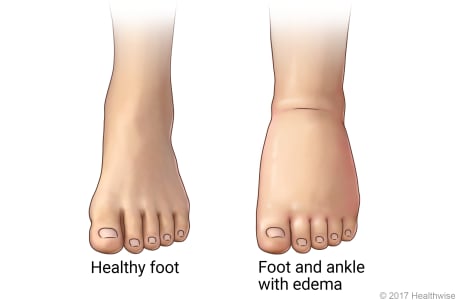Jump to
Swelling (edema) of the foot and ankle

Swelling (edema) of the foot and ankle may be called pedal edema.
How can you care for leg and ankle edema?
- If your doctor gave you medicine, take it as prescribed. Call your doctor if you think you are having a problem with your medicine.
- Whenever you are resting, raise your legs up. Try to keep the swollen area higher than the level of your heart.
- Take breaks from standing or sitting in one position.
- Walk around to increase the blood flow in your lower legs.
- Move your feet and ankles often while you stand, or tighten and relax your leg muscles.
- Wear support stockings. Put them on in the morning, before swelling gets worse.
- Eat a balanced diet. Lose weight if you need to.
- Limit the amount of salt (sodium) in your diet. Salt holds fluid in the body and may increase swelling.
Leg and ankle edema: When to call
Call 911 anytime you think you may need emergency care. For example, call if:
- You have symptoms of a blood clot in your lung (called a pulmonary embolism). These may include:
- Sudden chest pain.
- Trouble breathing.
- Coughing up blood.
Call your doctor now or seek immediate medical care if:
- You have signs of a blood clot, such as:
- Pain in your calf, back of the knee, thigh, or groin.
- Redness and swelling in your leg or groin.
- You have symptoms of infection, such as:
- Increased pain, swelling, warmth, or redness.
- Red streaks or pus.
- A fever.
Watch closely for changes in your health, and be sure to contact your doctor if:
- Your swelling is getting worse.
- You have new or worsening pain in your legs.
- You do not get better as expected.
©2011-2026 Healthwise, Incorporated
The content above contains general health information provided by Healthwise, Incorporated, and reviewed by its medical experts. This content should not replace the advice of your healthcare provider. Not all treatments or services described are offered as services by us. For recommended treatments, please consult your healthcare provider.
